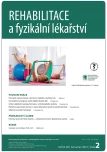Influence of footbike riding on the locomotor system of younger school children
Authors:
Třískala Z. 1; Jandová D. 2; Morávek O. 2; Musílek M. 3; Wurstová I. 3; Škvařilová V. 3; Filó L. 4; Jurčáková E. 4; Kalina M. 4; Lukáčová D. 4
Authors‘ workplace:
Český inspektorát lázní a zřídel, Ministerstvo zdravotnictví ČR
1; MediCentrum JONA s. r. o., Praha
2; Státní léčebné lázně Bludov, s. p.
3; Priessnitzovy léčebné lázně a. s., Jeseník
4
Published in:
Rehabil. fyz. Lék., 28, 2021, No. 2, pp. 67-74.
Category:
Original Papers
doi:
https://doi.org/10.48095/ccrhfl202167
Overview
The authors present the results of a pilot study of basic research into the effect of the footbike riding (bipedal locomotion) on the locomotor system in 39 younger school children (aged 6–12 years). The control group without scooter rides consisted of 10 children. A battery of locomotor system tests, anthropometric measurements, bioimpedance methods and saliva sampling for cortisol levels were used for objectification. The article presents the first part of data from the total dataset, which present the results of changes in the length of shortened selected muscles – the rectus femori muscle, iliopsoas and changes in the parameter of total dysfunction of the musculoskeletal system assessed by the expert information system Computer Kinesiology. The study proves the positive effect of comprehensive spa treatment and rehabilitation care for all children. In addition, the study showed a positive effect of footbike riding on the functions of the locomotor system. Positive changes in the musculoskeletal system in the control group were less significant.
Keywords:
footbike riding – locomotor system – shortened muscles – Computer Kinesiology – balneotherapy
Sources
1. Kunešová M, Kalousková P, Taxová Braune-rová R et al. Obézní pacient v ordinaci praktického lékaře. Čas Lék Čes 2020; 159: 104–110.
2. Kytnarová J, Aldhoon Hainerová I, Boženský J et al. Obezita u dětí. Standard léčebného plánu. Česká obezitologická společnost ČLS JEP 2011. [online]. Dostupné z: www.obesitas.cz/download/doporuceny_postup_prevence_a_lecby_detske_obezity.pdf.
3. Neumannová K, Kolek V et al. Astma bronchiale a chronická obstrukční plicní nemoc. Praha: Mladá Fronta 2018: 67–74.
4. Kolář P et al. Rehabilitace v klinické praxi. Praha: Galén 2009: 159–169.
5. Lewit K. Zřetězení funkčních poruch pohybové soustavy. Čas Lék Čes 1987; 4: 1310–1312.
6. Véle F. Vyšetření hybných funkcí z pohledu neurofyziologie. Praha: Triton 2012.
7. Pastucha D, Chmelík F, Canibal H et al. Pohybová aktivita v prevenci a terapii dětské obezity. Čes-slov Pediat 2019; 74(2): 102–105.
8. Blair J, Adaway J, Keevil B et al. Salivary cortisol and cortisone in the clinical setting. Curr Opin Endocrinol Diabetes Obes 2017; 24(3): 161–168. doi: 10.1097/MED.0000000000000328.
9. Bross JM, Fetto J, Rosen E. Vyšetření pohybového aparátu. Praha: Triton 2005: 410–483.
10. Gúth A. Rehabilitácia pro medicínské, pedagogické a ošetrovatelské odbory. Bratislava: Liečŕeh 2014: 96–102.
11. Gúth A. Propedeutika v rehabilitácii pre fyzioterapeutov. Bratislava: Liečreh 2006: 54–68.
12. Gúth A. Vyšetrovacie metodiky v rehabilitácii. Bratislava: Liečeh 2008: 74–82.
13. Janda V. Základy kliniky funkčních (neparetických) hybných poruch. Brno: ÚDVZP 1982: 85–88.
14. Janda V et al. Svalové funkční testy. Praha: Grada 2004: 311–328.
15. Jandová D. Existence expertních informačních systémů ve fyzioterapii. Rehabil Fyz Lék 2009; 16(4): 150–154.
16. Jandová D, Morávek O. Změny v pohybovém systému po Nordic walking. Rehabil Fyz Lék 2011; 18(2): 47–49.
Labels
Physiotherapist, university degree Rehabilitation Sports medicineArticle was published in
Rehabilitation & Physical Medicine

2021 Issue 2
Most read in this issue
- The effect of manipulation therapy on cervicocranial syndrome
- Historical development of motor control theories – from hierarchical theory to dynamic system
- Influence of footbike riding on the locomotor system of younger school children
- Effectiveness of therapeutic interventions in the treatment of pain associated with trigger points
